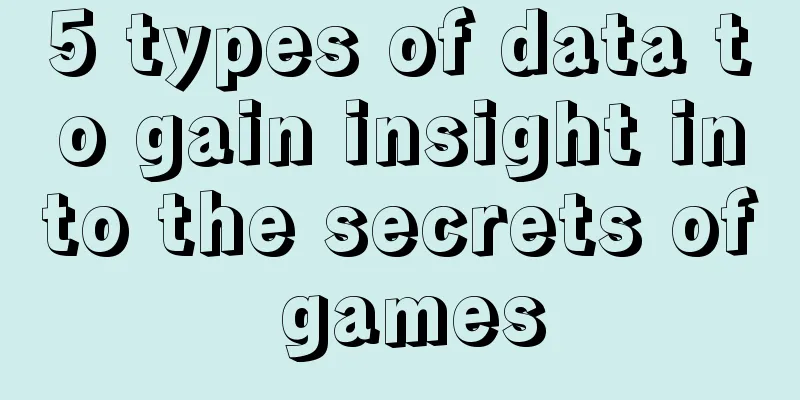5 types of data to gain insight into the secrets of games

Data is like a window, through which we can see many secrets inside the game world. These secrets are like treasures hidden deep in the room. Only by truly understanding and making good use of them can we create more attractive games and form a more successful business model. A key question is: What windows are there, and how can we open them? 1. User BehaviorFrom this window, we can see the secrets of user-related behavioral patterns. Common indicators such as daily active users (DAU), average revenue per user (ARPU), retention rate, return on investment (ROI), or analyses such as novice funnel and activity funnel are all obtained through this part of data. The core of collecting this part of data is reasonable in-app embedding, and the design of events and attributes is of utmost importance. The point collection in the game is usually divided into two parts, one from the client and the other from the server. As for the point collection on the server, its data is not easily lost and is more accurate. Therefore, behaviors such as "payment" that require more accurate statistics will be collected through the server-side point collection. As for the point collection on the client, it is the top priority of the gaming industry. Because for other industries, client-side tracking data is usually a supplement to server-side tracking data. For example, for e-commerce apps, analyzing the user's operational behavior path on the interface may not be as meaningful as analyzing the user's final transaction behavior. After all, in many industries, many client behaviors are not the core experience and are not causally related to each other. In the gaming industry, the entire experience of a game is in every step of the player's operation. If the player has a poor experience in a certain detail, he or she may leave, but if he or she gets great pleasure from a certain detail, it is possible to create greater value. Take Hearthstone as an example. After playing a card, you can speed up the animation by clicking on the interface. Therefore, this type of click acceleration or skipping animation operation is not suitable for placing points on the server side. For other industries, whether the interface animation effect in an APP is accelerated is not the core of optimization, but in the game industry, you can even distinguish two types of users based on this: one is Buddhist, who enjoys the process, and the other is aggressive, who enjoys the result. With this understanding, the function design and operation methods for the subdivided groups will be different. User behavior data is very large, highly flexible, and can be analyzed in a variety of ways. If used well, it is the most objective and subtle reflection of the entire game. Therefore, it requires the support of relatively powerful tools, such as Sensors. However, user behavior data is not omnipotent. First of all, it must be based on statistical analysis of behaviors that have already occurred in the APP. It is powerless for the fact that behaviors have not occurred in the APP. Secondly, it may be difficult to intuitively give the changes in the system itself from the perspective of using user behavior data for analysis. That is to say, we can intuitively see the user's behavior through user behavior data, but the game is a complex system. User behavior itself will cause a chain reaction in the system itself, and there will be no behavior points in these chain reactions. Therefore, it is difficult to track this part of the changes with just user behavior data. But wait, we still have four other windows. 2. Game SnapshotsIt mainly refers to the running snapshot of the game at a certain moment, through which we can see the balance and design of each system of the game under a certain time slice. This part of data is of great significance for self-evolving complex systems. Let's take the game "Civilization" as an example. From a certain perspective, "Civilization" is building an engine. Once this engine is built, it will continuously generate resources. The player's behavior is just to transform the engine. The operation of the engine is driven by time. At this time, regular operation snapshots based on the server are more important for the evolution analysis of the game system itself. For example, we want to see how the various resources in the game will change over time? Is there a correlation between the changes in resource A and resource B? For example, the fluctuation of the number of wood and the number of gold coins always show a trigonometric relationship, and they are exactly balanced after adding each other. This means that in game design, the two resources may be convertible to each other, which also means that the total amount of resources may be used as a criterion for measuring the balance of the game. However, the methods of collecting this data in the market are usually different. The more common method is to directly save snapshots of the server database regularly. 3. Performance dataIt is similar to snapshot, but more technical, because the gaming experience is crucial, and performance is the most direct factor affecting the experience. In fact, in order to achieve the required performance, many games have made a lot of technical innovations. For example, the client prediction technology of games such as "Overwatch", and a series of rendering technologies such as texture compression, LOD, deferred rendering, lighting pre-calculation, Occlusion Culling, etc., although it costs a huge price, it is all for players to "enjoy smoothness" when operating. This part of data is usually not recorded in the user behavior tracking point, such as FPS, loading time, memory usage, PING, crash rate, etc. In order to collect this performance data, developers usually use various tools, mainly in the following categories: 1. Analysis tools that come with the game engine: such as Unity's Profiler tool and Unreal Engine's Performance Profiler. 2. Tools provided by device manufacturers: such as Apple's Instruments and Android's Profiler. 3. Third-party performance analysis tools: such as GameBench, RenderDoc, Pix, etc. 4. Customized DEBUG logs: Add custom logs to your code to collect and analyze specific performance data. 4. Community FeedbackThis window will show us the data of players' behaviors outside the game. This part of data is particularly valuable and effective because it can reflect the real overall emotions of players. For example, in the comments on Steam, we often see a game being rated badly, but the comment is "We need Chinese!" These are the most real feedback from players. In the process of game development abroad, this aspect is particularly valued. For example, in the development of "Slay the Spire", the development team first used Slack to collect feedback on a small scale. After EA, they collected a large amount of feedback on Discord. The development team will check the user feedback one by one. To collect this data, we first need similar community tools or platforms, such as slack, discord, steam, taptap, etc., or Appstore reviews and direct feedback in the customer service system, which are also important sources. Secondly, you need tools and techniques to analyze data, whether it is manual viewing, using machine learning technology to collect keywords, sentiment analysis, or summarizing with LLM, the purpose is to tap the value of this part of the data. In fact, this part of data is easier to obtain in the early stage, and it is also the most valuable data. However, as the game becomes more popular in the later stage, the amount of data increases, and the technical threshold required for analysis rises accordingly. This may be a happy trouble, and game developers seem to need this happy trouble. 5. Market DataThis part of data is also divided into two parts. One part is market data related to the game itself. For example, if you use advertising for promotion, then the cost and effect of advertising are crucial. For advertising data, accurate effect tracking is a must. The second part is the overall market, the situation of competitors, and the current hot advertising materials. After all, only by knowing yourself and the enemy can you win every battle. These five types of data, from user behavior data to market data, each provide a different perspective for game data analysis. As new technologies continue to emerge, the game's research and development and operation processes will continue to iterate and change, and new windows and means will continue to emerge. |
<<: When merchants operate Xiaohongshu, they should not ignore these 8 basic settings
>>: Data Analyst, how to find a job for yourself
Recommend
Oriental Selection and Brother Yang are going overseas together. Are they trying to make a lot of money from foreigners?
The live broadcast circle has been lively again re...
How to build a Shopify independent website?
There are still many merchants who have Shopify in...
520 is quiet. How can brands that cannot sell love do “reverse marketing”?
This article explores the current status of 520 ho...
What do the hot-selling products on Pinduoduo look like?
In the fiercely competitive e-commerce market, how...
Do I need an external network to open a store on Amazon? Do I need to bypass the firewall?
If you want to register on Amazon, you need to sub...
AI photo editing to replace the hippocampus? It's possible, but don't even think about making money
As a popular photo studio, can the hippocampus sti...
Flying towards the future, meeting new potential - Feilaihui appeared at the 2024 APEC SME Cross-border E-commerce Summit
On March 26, as an ecological partner of DHgate.co...
What kind of inspiration does the popularity of "Black Myth: Wukong" give to brands?
The explosive popularity of "Black Myth: Wuko...
Young people only go to B1B2 when shopping in shopping malls - new changes in consumption trends
Recently, "reverse consumption" has beco...
How much does it cost to invest in Amazon's no-source model? What ERP should be used?
It is not only Taobao, Pinduoduo and other domesti...
Alibaba and JD.com shake hands and make peace
How did Alibaba and JD.com, two heavyweight player...
How to apply for Amazon advertising discount coupons? What are the conditions for participation?
There are many activities launched on the Amazon p...
Selling milk tea at a stall and earning 50,000 yuan a month? I found 6 good products at the popular night market across the country
"Staying on the street" is popular. Many...
How to do Amazon market research and analysis? How much money is needed to do Amazon?
As one of the world's largest online retail pl...
Operational skills and experience
In the actual operation of operations, what points...









